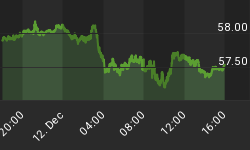Does the price action of gold of late make you scratch your head, falling as it has from its recent high of $1,420 to $1,359 as I write? Hard not to make one wonder, considering the nature of so much recent breaking news...
- Consumer prices in December exceeded forecasts, up 0.5%, with core inflation up 1%.
- Producer prices rose 1.1% in December.
- China's inflation, at over 5%, is beginning to cause problems.
- Import prices into the U.S. are on the rise.
- The European Central Bank is now warning of inflation, and interest rates there continue to rise.
- Back in the U.S., the rise in interest rates is becoming persistent, with 10-year Treasury rates moving from 2.57% in November to 3.31% today - something that Bernanke is trying to spin as a positive, but given the amount of debt sloshing about, it is very much not.
- Oil - the stuff that makes the world go 'round - appears stuck at around $90, no matter whether the news is good, or bad.
- The U.S. government is trying to chase foreign depositors away from the dollar by broadcasting that the IRS wants to begin looking in to all foreign-held U.S. bank accounts. Trying to keep ahead of the curve, JP Morgan, among others, has told foreign account holders they have to close their accounts by March 31. The harder it becomes to do business with the U.S., the weaker the demand for dollars. The weaker the demand for the dollar, the weaker the dollar will be... interest rates will have to rise to offset the fall, and import prices will go up even further.
- Following that thread, China and Russia have recently struck a deal to bypass the U.S. dollar in bilateral trade - the latest and most substantial act of foreign nations taking active measures to ditch the dollar.
- Food prices are soaring - with corn contracts up over 90% from June lows, and wheat up 80%.

And, yet, gold goes down.
Doesn't make much sense, does it?
In my firmly held opinion, what we're seeing is nothing more than the consequences of Mr. Market's confusion - about gold, about the dollar, about Europe, about Asia... and especially about the potential consequences of Uncle Sam's massive meddling in all manner of markets. Thus Mr. Market desperately looks to the equally confused punditry for an explanation, and gets fed a lot of nonsense and hoo ha about "risk on" and "risk off," and the benefits of the governments "quantitative easing," and so on.
Don't let yourself be confused in the slightest about what's going on, and pay no attention to the punditry. The analysis they do is garden variety at best, and they have it dead wrong... just as they almost always do.
To make that point, I'll share a quote from the excellent book When Money Dies, referring to the Vossische Zietung, one of Germany's leading financial newspapers back in the 1920s as the inflation began to spin dangerously out of control:
The Chancellor would accept no connection between printing money and its depreciation. Indeed, it remained largely unrecognized in Cabinet, bank, parliament or press. The Vossische Zietung of August 16 declared that...
... the opinion that the flood of paper is the real origin of the depreciation is not only wrong but dangerously wrong... Both private and public statistics have long shown that for the last two years the interior depreciation of the mark is due to the depreciation of the rate of exchange... it should be remembered today that our paper circulation, although it shows on paper a terrifying array of millards, is really not excessively high... we have no 'dangerous flood of paper'...
Another particularly telling quote from around the same time was from the Berliner Borsen Courier:
It has long been realized that the printing of notes is the result not the cause of depreciation, and that the amount of currency, as it increases in bulk, is really decreasing in value. A point has now been reached where the lack of money has a worse effect than the depreciation itself... Even should the quantity of paper money be three times its present size, it would constitute no real obstacle to stabilization.
Until such a time, therefore, let us print notes!
At the time of that quote, the money printing in Germany had pushed the mark from 5 to the dollar to over 1800. Yet, almost no one in a position of influence was connecting the dots.
That's much as is the case today. Until there has been a fundamental shift in U.S. fiscal and monetary policy, I would like to strongly suggest you trust your own instincts about the relative value of holding gold versus dollars - or any of the fiat currencies, for that matter - and set your sails accordingly.
Or, you can listen to Bernanke, who said yesterday:
"Interest rates are higher, but I think that's mostly because the news is better. It's responding to a stronger economy and better expectations. So I think that the policy has helped."
And, don't forget: historically interest rates, gold, and inflation all rise together. Not until we see positive real interest rates - interest rates that clearly outstrip the depreciation of the currency - will gold stop being a good investment. We are nowhere near that point.
The case for gold is getting stronger by the day - if you don't have any yet, buy some today. For answers on where to get it, where to store it, and when to sell it, read BIG GOLD, the go-to advisory for gold, silver, and large-cap precious metals stocks. Subscribe today for only $79 per year, and you'll also receive 12 FREE monthly issues of Casey's Energy Opportunities. Details here.
















